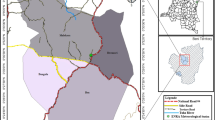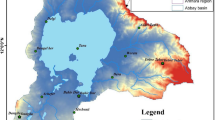Abstract
The economic challenges related to the fields of agriculture and industry led us to adopt the best suited method to represent the rain on the spatial and temporal plan especially in areas characterized by heterogeneous rainfall distribution additionally to drought periods. The methods of analysis and estimation of rainfall, using a number of tools (statistics, geostatistics and digital mapping), provide the opportunity to represent the average inter-yearly rainfall fields in the eastern high plateaus region of Algeria. In this study, an approach was proposed for yearly rainfall characterization. Data series for the period 1986–2007 were collected from 65 rain-gauging stations. This approach is based on two combined methods (geostatistic and multiple linear regression) including direct relationship between rainfall and geographical parameters (longitude, latitude and altitude). Statistical analysis indicates that the annual rainfall values ranges from 127 to 752.2 mm and that their distribution is Platykurtic. Results show that yearly rainfall structure obeys mainly a north/south gradient, and latitude is the most influential geographical parameter with a coefficient of 261.25 contrary to the longitude (17.06) and altitude (0.04) which have a non-significant effect on precipitation. In addition, other factors such as vegetation, temperature and air mass movement affect negatively the rainfall structure. Moreover, the map of rainfall indicates that the rain bands ranging from 300 to 400 mm dominate 58 % of the total study area whereas rain bands greater than 400 mm occupy 37 % of the total study area.







Similar content being viewed by others
References
Ahrens B (2006) Distance in spatial interpolation of daily rain gauge data. Hydrol Earth Syst Sci 10: 197–208. www.hydrol-earth-syst-sci.net/10/197/2006/
Arnaud M and Emery X (2000) Estimation et interpolation spatiale, Méthodes déterministes et méthodes géostatistiques. Hermes science Europe
Ashiq M-W, Zhao C, Ni J, Akhtar M (2010) GIS-based high-resolution spatial interpolation of precipitation in mountain–plain areas of upper Pakistan for regional climate change impact studies. Theor Appl Climatol 99:239–253. doi:10.1007/s00704-009-0140-y
Bahlouli F, Bouzerzour H, Benmahammed A (2008) Effets de la vitesse et de la durée du remplissage du grain ainsi que de l’accumulation des assimilats de la tige dans l’élaboration du rendement du blé dur (Triticum durum Desf.) dans les conditions de culture des hautes plaines orientales d’Algérie. Biotechnol Agron Soc Environ 1:31–39
Bargaoui Z-K, Chebbi A (2009) Comparison of two kriging interpolation methods applied to spatiotemporal rainfall. J Hydrol 365:56–73. doi:10.1016/j.jhydrol.2008.11.025
Benabdesselam T, Amarchi H (2013) Regional approach for the estimation of extreme daily precipitation on north-east area of Algeria. Int J Water Ress Environ Eng 5(10):573–583. doi:10.5897/IJWREE12.071
Bertrand-Krajewski J-L, Laplace D, Joannis C (2000) Mesures en hydrologie urbaine et assainissement, Paris (France). Tech, ET Doc
Bostana P-A, Heuvelink G-B-M, Akyurekc S-Z (2012) Comparison of regression and kriging techniques for mapping the average annual precipitation of Turkey. Int J Appl Earth Obser Geoinfo 19:115–126. doi:10.1016/j.jag.2012.04.010
Brunsdon C, Mcclatchey J, Unwin D-J (2001) Spatial variations in the average rainfall–altitude relationship in Great Britain: an approach using geographically weighted regression. Int J Climatol 21:455–466. doi:10.1002/joc.614
Bulmer M-G (1979). Principles of statistics. Dover 108–123
Chaumont M. and Paquin C (1971) Carte pluviométrique de l’Algérie du Nord à l’échelle 1/500 000, carte plus notice. Soc Hist Nat. Afrique du Nord, Alger. 25p
Chua S, Bras R-L (1982) Optimal estimators of mean annual rainfall in regions of orographic influences. J Hydrol 57:23–48
Cook R-D (1977) Detection of influential observations in linear regression. Technometrics 19:15–18
Cook E-R, Briffa K-R, Jones P-D (1994) Spatial regression methods in dendroclimatology—a review and comparison of 2 techniques. Int J Climatol 14:379–402
Delhomme J-P (1976) Application de la théorie des variables régionalisées dans les sciences de l’eau. Thèse Doct., Université de Pierre et Marie Curie- Paris. 129p
Delli G, Sarfatti P, Bazzani F (2002) Application of GIS for agro-climatological characterization of northern Algeria to define durum wheat production area. J agri environ inter develop 96:3
Dingman S, Seely D, Reynolds R (1988) Application of kriging to estimate mean annual rainfall in a region of orographic influence. Water Res Bull 24:329–339
Goodale C-L, Aber J-D, Ollinger S-V (1998) Mapping monthly precipitation, temperature, and solar radiation for Ireland with polynomial regression and a digital elevation model. Clim Res 10:35–49
Goovaerts P (2000) Geostatistical approaches for incorporating elevation into the spatial interpolation of rainfall. J Hydrol 228:11–129
Hamlaoui-Moulai L, Mesbah M, Souag-Gamane D, Medjerab A (2013) Detecting hydro-climatic change using spatiotemporal analysis of rainfall time series in western Algeria. Nat Hazards 65(3):1293–1311. doi:10.1007/s11069-012-0411-2
Hay L, Viger R, Mccabe G (1998) Precipitation interpolation in mountainous regions using multiple linear regressions. Hydrol Water Resour Ecol Headwaters 248:33–38
Hevesi J, Flint A, Istok J (1992) Rainfall estimation in mountainous terrain using multivariate geostatistics: part 1 and 2. J Appl Meteo 31:66–688
Johnson G-L, Hanson C-L (1995) Topographic and atmospheric influences on rainfall variability over a mountainous watershed. J Appl Meteo 34:68–74
Kyriakidis P-C, Journel AG (1999) Geostatistical space-time models. Math Geol 6(31):651–684
Lam N (1983) Spatial interpolation methods. American Cartographer 10(2):129–149
Lloyd C-D (2005) Assessing the effect of integrating elevation data into the estimation of monthly precipitation in Great Britain. J Hydol 308:128–150
Lloyd C-D (2010) Multivariate interpolation of monthly precipitation amount in the United Kingdom. geoENV VII. Geostatistics for Environmental Applications, Quantitative Geology and Geostatistics 16, Springer Science + Business Media. doi:10.1007/978-90-481-2322-33
Marks D, Winstral A, Reba M, Pomeroy J, Kumar M (2013) An evaluation of methods for determining during-storm precipitation phase and the rain/snow transition elevation at the surface in a mountain basin. Adv Water Resour 55:98–110. doi:10.1016/j.advwatres.2012.11.012
Matheron G (1965) Les variables régionalisées et leur estimation. Edition Masson & Cie, Paris 306p
Meddi M, Toumi S (2013) Study of the interannual rainfall variability in northern Algeria. L J E E 23:40–59
Meddi M, Toumi S (2015) Spatial variability and cartography of maximum annual daily rainfall under different return period in the north of Algeria. J Mt Sci 12(6):1403–1421
Miniscloux F, Anquetin S, Creutin J-D (2001) Geostatistical analysis of orographic rainbands. J Appl Meteo 40(11):1835–1854
Myoung-Jin U-M, Hyeseon Y, Chang-Sam J, Jun-Haeng H (2012) Factor analysis and multiple regression between topography and precipitation on Jeju Island, Korea. J Hydrol 410:189–203. doi:10.1016/j.jhydrol.2011.09.016
Naoum S, Tsanis I-K (2004) A multiple linear regression GIS module using spatial variables to model orographic rainfall. J Hydroinf 06(1):39–56
Ouallouche F, Ameur S (2014) Rainfall detection over northern Algeria by combining MSG and TRMM data. Appl Water Sci 6:1–10. doi:10.1007/s13201-014-0204-8
Palecki M-A, Angel J-R, Hollinger S-E (2005) Storm precipitation in the United States. Part I: Meteorol Charact J Appl Meteo 44:933–946
Pannatier Y (1996) Variowin—software for spatial data analysis in 2D. Springer Verlag, notice 91p
Piccini C, Marchetti A, Farina R, Francaviglia R (2012) Application of indicator kriging to evaluate the probability of exceeding nitrate contamination thresholds. Int J Environ Res 6(4):853–862
Prise D-T, McKenney D-W, Nalder I-A, Hutchinson M-F, Kesteven J-L (2000) A comparison of two statistical methods for spatial interpolation of Canadian monthly mean climate data. Agri Forest Meteo 101:81–94
Queney P (1937) Le régime pluviométrique de l’Algérie et son évolution depuis 1850. Météorologie 427-440
Queney P (1943) Les fronts atmosphériques permanents et leurs perturbations. (Travaux de l’Institut de Météorologie, fasc. 3. Alger. pp1–6
Rosenberg M (1969) Hydrologie. Choix d’un modèle régional expliquant la répartition des précipitations annuelles dans l’espace en fonction des facteurs climatiques et topographiques CRAC Sci 761–764
Sangati M, Borga M (2009) Influence of rainfall spatial resolution on flash flood modelling. Nat Hazards Earth Syst Sci 9(2):575–574. doi:10.5194/nhess-9-575-2009
Seltzer P (1948) Le climat de l’Algérie. Inst. Météorol. Phys, Globe, Alger 219p
Sheather S-J (2009) A modern approach to regression with R, chapter 5: multiple linear regression. Springer Science –Business Media 125–149
Skirvin S-M, Marsh S-E, McClaran M-P, Meko D-M (2003) Climate spatial variability and data resolution in a semi-arid watershed, southeastern Arizona. J Arid Environ 54:667–686. doi:10.1006/jare.2002.1086
Slimani M, Cudennec C, Feki H (2007) Structure of the rainfall gradient in the Sahara transition in Tunisia: geographical determinants and seasonality. Hydrol Sci J 52(6):1088–1102. doi:10.1623/hysj.52.6.1088
Smadhi D, Zella L (2012) The pluviometrical deficiencies in the pluvial cereal regions in Algeria. Afric Jour of Agric Resea 7(48):6413–6420. doi:10.5897/AJAR12.1838
Snee R-D (1986) An alternative approach to fitting models when re-expression of the response is useful. J Quality Techno 18:211–225
Subyani A-M (2004) Geostatistical study of annual and seasonal mean rainfall patterns in southwest Saudi Arabia. Hydrol Sci J 49(5):803–817. doi:10.1623/hysj.49.5.803.55137
Subyani A-M, Al-Dakheel A-M (2009) Multivariate geostatistical methods of mean annual and seasonal rainfall in southwest Saudi Arabia. Arab J Geosci 2:19–27. doi:10.1007/s12517-008-0015-z
Touazi M, Laborde J-P, Bhiry N (2004) Modelling rainfall-discharge at a mean inter-yearly scale in northern Algeria. J Hydro 296:179–191. doi:10.1016/j. jhydrol.2004.03.030
Touchan R, Anchukaitis KJ, Meko DM, Sabir M, Attalah S, Aloui A (2011) Spatiotemporal drought variability in northwestern Africa over the last nine centuries. Clim Dyn 37:237–252. doi:10.1007/s00382-010-0804-4
Valipour M (2012) Critical areas of Iran for agriculture water management according to the annual rainfall. Eur J Sci Res 84:600–608
Valipour M (2015a) A comprehensive study on irrigation management in Asia and Oceania. Arch Agron Soil Sci 61(9):1247–1271. doi:10.1080/03650340.2014.986471
Valipour M (2015b) Future of agricultural water management in Africa. Arch Agron Soil Sci 61(7):907–927. doi:10.1080/03650340.2014.961433
Valipour M (2015c) Long-term runoff study using SARIMA and ARIMA models in the United States. Meteorol Appl 22(3):592–598. doi:10.1002/met.1491
Valipour M (2016) Optimization of neural networks for precipitation analysis in a humid region to detect drought and wet year alarms. Meteorol Appl 23(1):91–100. doi:10.1002/met.1533
Valipour M, Ziatabar Ahmadi M, Raeini-Sarjaz M, Ali Gholami Sefidkouhi M, Shahnazari A, Fazlola R, Darzi-Naftchali A (2015) Agricultural water management in the world during past half century. Arch Agron Soil Sci 61(5):657–678. doi:10.1080/03650340.2014.944903
Vargas-Guzman J-A, Myers D-E, Warrick A-W (2000) Derivates of spatial variances of growing windows and the variogram. Math Geol 32(7):851–871
Walpole R-E, Myers R-H, Myers S-L and Ye K (2007) Probability and statistics for engineers and scientists. , 8th ed., Pearson Prentice Hall, Pearson Prentice Hall 791p
Zekai S, Zeyad H (2000) Spatial precipitation assessment with elevation by using point cumulative semivariogram technique. Water Resour Manag 14:311–325
Acknowledgments
The authors extend special thanks to the following Algerian institutions: National Meteorological Office (O.N.M), National Agency for Water Resources (A.N.R.H) and National Institute of Maps and Remote Sensing (I.N.C.T), for providing climatic data and maps. The authors are thankful to the National Institute of Agronomic Research (I.N.R.A) and to the National Institute of Soil, Irrigation and Drainage (I.N.S.D) for the logistic support.
Author information
Authors and Affiliations
Corresponding author
Additional information
This article is part of the Topical Collection on Water Resources in Arid Areas
Rights and permissions
About this article
Cite this article
Bachir, H., Semar, A. & Mazari, A. Statistical and geostatistical analysis related to geographical parameters for spatial and temporal representation of rainfall in semi-arid environments: the case of Algeria. Arab J Geosci 9, 486 (2016). https://doi.org/10.1007/s12517-016-2505-8
Received:
Accepted:
Published:
DOI: https://doi.org/10.1007/s12517-016-2505-8




